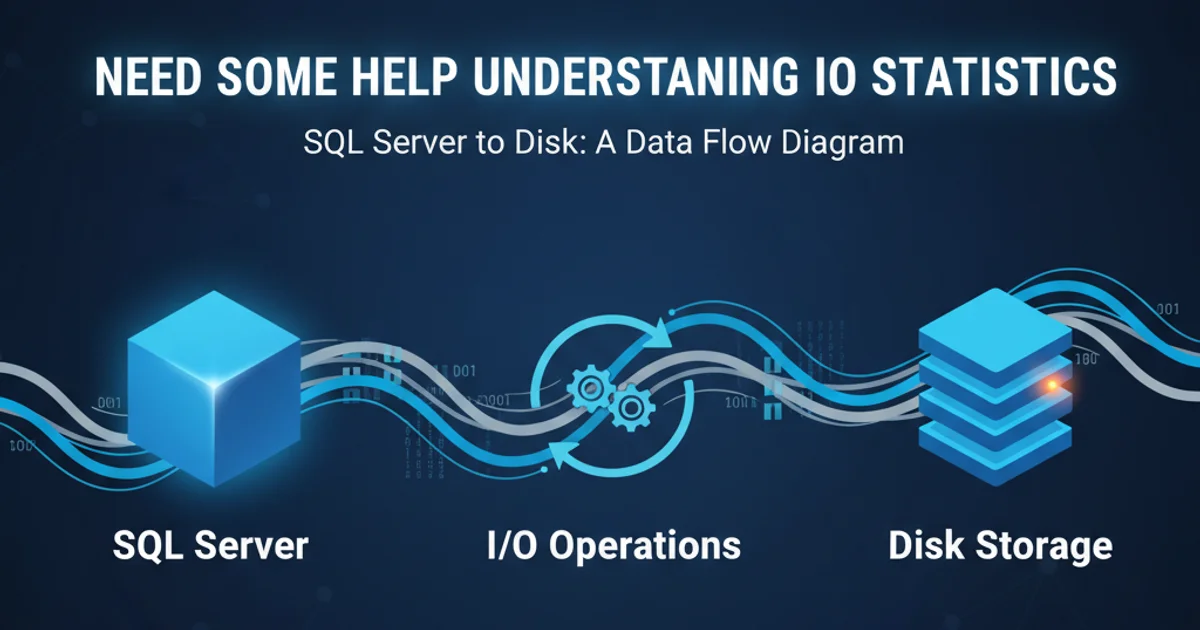Need some help understanding IO Statistics
Understanding SQL Server I/O Statistics for Performance Tuning

Dive deep into SQL Server I/O statistics to diagnose performance bottlenecks, understand disk activity, and optimize your database operations.
Input/Output (I/O) operations are a critical component of any database system's performance. In SQL Server, understanding I/O statistics is fundamental to identifying and resolving performance bottlenecks. When queries run slowly, it's often due to excessive disk I/O, which can be caused by inefficient queries, missing indexes, or inadequate hardware. This article will guide you through the process of collecting and interpreting SQL Server I/O statistics, focusing on key metrics like logical reads, physical reads, and write operations.
Collecting I/O Statistics with SET STATISTICS IO
The primary tool for collecting I/O statistics for a specific query in SQL Server is the SET STATISTICS IO ON command. When enabled, SQL Server will output detailed information about the disk activity generated by subsequent queries. This information is crucial for understanding how much data SQL Server is reading from cache (logical reads) and from disk (physical reads).
SET STATISTICS IO ON;
GO
SELECT *
FROM Production.Product
WHERE ProductID = 771;
GO
SET STATISTICS IO OFF;
GO
Example of enabling and disabling SET STATISTICS IO for a query.
After executing the query with SET STATISTICS IO ON, the results pane (or messages tab in SSMS) will display output similar to this:
Table 'Product'. Scan count 1, logical reads 2, physical reads 0, read-ahead reads 0, lob logical reads 0, lob physical reads 0, lob read-ahead reads 0.
Let's break down these key metrics:
SET STATISTICS IO OFF after you are done analyzing a query to avoid cluttering your output with unnecessary statistics for subsequent operations.Interpreting Key I/O Metrics
Understanding what each metric signifies is vital for effective performance tuning. Each type of read or write operation tells a different story about how your query interacts with the database's storage subsystem.
flowchart TD
A["Query Execution"] --> B{"Data in Buffer Pool?"}
B -->|Yes| C["Logical Reads"]
B -->|No| D["Physical Reads"]
D --> E["Data from Disk"]
E --> C
C --> F["Query Result"]Flowchart illustrating the decision process for logical vs. physical reads.
Logical Reads: This is the number of data pages read from the SQL Server buffer cache. These are generally fast operations as they don't involve disk access. A high number of logical reads often indicates an inefficient query or missing index, as SQL Server might be scanning more pages than necessary.
Physical Reads: This represents the number of data pages read directly from disk. These are much slower than logical reads and are a primary indicator of I/O bottlenecks. High physical reads suggest that the required data is not in the buffer cache, forcing SQL Server to go to disk.
Read-Ahead Reads: These are pages that SQL Server proactively reads into the buffer cache in anticipation of them being needed soon. While they are physical reads, they are often more efficient than on-demand physical reads because they are batched.
Write Operations: Although not directly shown in
SET STATISTICS IOoutput, write operations are also crucial. They involve writing data pages from the buffer cache to disk. High write activity can saturate disk I/O, especially during large data modifications or frequent checkpoints.
Diagnosing Performance Issues with I/O Statistics
Once you have collected I/O statistics, the next step is to analyze them to pinpoint performance problems. The goal is typically to minimize physical reads and, where possible, logical reads.
High Physical Reads: If your query shows a high number of physical reads, it means SQL Server is frequently going to disk. This could be due to:
- Insufficient Memory: The buffer pool might not be large enough to hold frequently accessed data, leading to pages being evicted and re-read from disk.
- Missing or Inefficient Indexes: Without proper indexes, SQL Server might resort to table scans, reading many more pages than necessary from disk.
- Outdated Statistics: Outdated statistics can lead the query optimizer to choose inefficient execution plans, resulting in more physical reads.
High Logical Reads: Even if physical reads are low, a very high number of logical reads can indicate an inefficient query. This means SQL Server is processing many pages from memory, which still consumes CPU resources and can block other operations. Common causes include:
- Table Scans: Queries without appropriate
WHEREclauses or indexes might scan entire tables. - Inefficient Joins: Poorly optimized joins can lead to reading many pages from multiple tables.
- Large Result Sets: Retrieving an unnecessarily large amount of data will naturally increase logical reads.
- Table Scans: Queries without appropriate
SET STATISTICS IO is excellent for individual query analysis, for server-wide I/O monitoring, consider using Dynamic Management Views (DMVs) like sys.dm_io_virtual_file_stats or Performance Monitor counters.1. Identify Problematic Queries
Use tools like SQL Server Profiler, Extended Events, or the Query Store to find queries with high execution times or resource consumption.
2. Collect I/O Statistics
Run SET STATISTICS IO ON before executing the identified query to capture its I/O footprint.
3. Analyze Logical and Physical Reads
Examine the output. Focus on reducing physical reads first, then optimize for logical reads.
4. Implement Optimizations
Based on your analysis, consider adding or modifying indexes, rewriting queries, updating statistics, or increasing server memory.
5. Re-evaluate and Iterate
After making changes, re-run the query with SET STATISTICS IO ON to verify the improvements. Performance tuning is an iterative process.